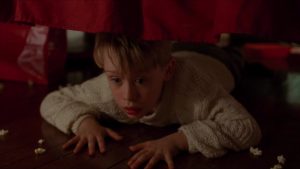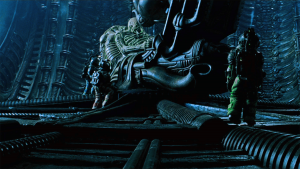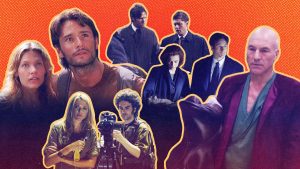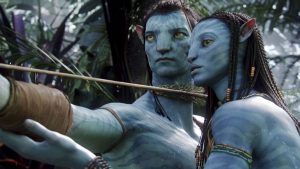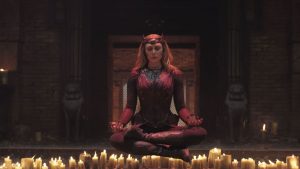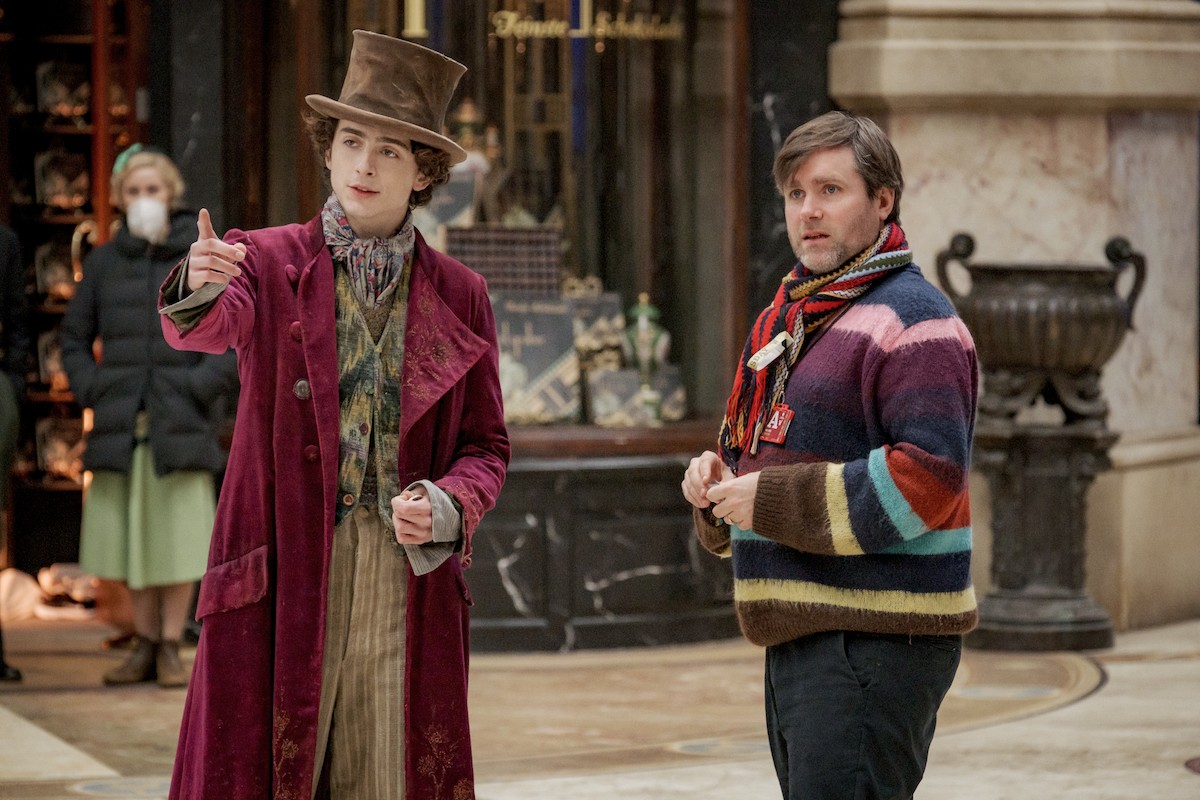
Two words: Young Wonka. This was the pitch from celebrated producer David Heyman to director Paul King at the end of their time working together on Paddington 2, according to King. “I think it was literally our last sign-off,” he smiles. Food for thought, right?
Several years and a pandemic later, their fruitful collaboration is finally making its way to screens in a whirlwind of color and candy.
“It was definitely the idea to try to make something that would be warming and festive at Christmas,” King says, but he’s quick to acknowledge that the world we live in today is not the same as the pre-COVID time of the film’s conception. It’s a production that faced obstacles out of King and Heyman’s hands, but in a bit of serendipity, the movie might just have arrived at exactly the time it was needed.
Based on a screenplay by King and Simon Farnaby, King’s Paddington co-writer, Wonka is a prequel, the tale of how Willy Wonka’s chocolate factory came to be. While it’s very referential to the 1964 novel (both King and Heyman are massive Roald Dahl fans), it’s also a spiritual forerunner to the 1971 movie Willy Wonka and the Chocolate Factory starring Gene Wilder and directed by Mel Stuart and includes several songs from that film.
“The Gene Wilder movie was my version of it growing up,” says King. “So I really wanted to do something that as much as possible could stand alongside those things and not make you go oh but hang on, and that’s not what happened in this’ or ‘no, no, the factory isn’t like that.’” That includes little nods in star Timothée Chalamet‘s performance. What results is a movie that strives to be faithful in spirit to Dahl and the Wilder film, with Easter eggs for those who enjoy the hunt.
If we are to believe that Chalamet’s Wonka becomes Wilder’s Wonka, the timeline is all-important. King reckons the ’71 film is more or less contemporaneous, so a little bit of math was involved in his setting.
“It’s quite hard to tell because Gene Wilder is 38, but he says he’s much older, and he’s looking for an heir and coming out of retirement. So I thought, ‘Well, maybe it’s about 25 years before that.’ So we settled on this post-war 1948 time period for it.”
Landing at just the right time could possibly be said for Chalamet’s Willy Wonka at the start of the movie, too, who first appears aboard a ship arriving at the non-specified European country where the film is set. He’s singing his heart out (make no mistake, this is a musical) and is armed with a (fast-diminishing) pocket full of silver coins and a head full of magical inventions, ready to make his fortune and share his chocolate with the world.
World of Pure Imagination Building
Though Wonka himself is clearly American, and Charlie and the Bucket family are British, King reckons Dahl’s story deliberately has an international feel. Though Mike Teavee is presumably meant to be from the U.S., Augustus Gloop sounds like he might be German, while Violet Beauregard’s name has a French vibe. Willy Wonka and the Chocolate Factory was shot on location in Germany, and so King’s initial plan was to do something similar. “I really liked the idea of that middle European vibe,” he says. “I also really fancied going on holiday. And I was like, hey, some rich American studio might pay me to go and live in Europe. That would be fun!” His dreams were not to be when COVID arrived, but this setback became a blessing when Warner Bros. told King and his team he’d just have to build his own city.
Working with production designer Nathan Crowley, the crew set about creating what King describes as an “extraordinary hybrid that’s got that whiff of storybook and nowheresville.”
The public face of the city is snobby opulence, with a central Galleria: a posh shopping mall where well-dressed customers peruse the minimal stores. This is where the young Willy Wonka will bring his exquisite confectionery and his unique showmanship, with hopes of earning enough money to open his own shop.
“I’ve always liked those quite snooty, rich European sort of towns where they go, ‘Velcome to the chocolate shop; there will be no fun or enjoyment or color,’” King jokes. “It felt like that would be a world that needed Willy Wonka to come in. He’s fun, and he’s going to bring color and light and liveliness.”
King describes the look of the backdrop for the city as muted, darker post-war colors, so Willy can appear like a pleasingly eccentric explosion with his iconic purple suit and magical chocolates with wild ingredients sourced from around the globe. It’s a mix of digital and practical effects, with real sets built that could be extended higher and wider with CGI and a real chocolate river, with digital enhancements, which still resulted in a chocolatey mess during certain scenes.
David Heyman is riding high on a wave of color in 2023. As the producer of Barbie, he’s already bagged the year’s biggest hit (coincidentally, he actually got to know Greta Gerwig and Noah Baumbach through the late Roald Dahl’s wife, Lissy), to add to his impressive roster—Heyman is the producer of all the Harry Potter movies among other massive successes. While he loves the visuals of Barbie and Wonka, it’s not color per se that appeals.
“That’s cinema, isn’t it? It’s a visual medium. Gravity‘s not colorful in that way. But it’s strong visual storytelling,” he explains. Heyman loves Dahl’s children’s books but also grew up on a diet of his darker fare—his macabre short story collections like Kiss, Kiss and Switch Bitch—so it was as important to him and to King to show the darker shades of Wonka’s story and to introduce us to the naive and open-hearted chocolatier while giving him a glimpse of the murkier sides of life.
“We wanted to show Willy before he was betrayed and before he locked himself away in the factory,” Heyman says. “The idea was to show a more innocent Willy. Someone who could lead up to eventually becoming Willy in the 1971 film, so that’s our iconography.”
What the Dickens?
There’s another side to the city—a seamier underworld of poverty and crime, which Willy encounters soon after he arrives. King says it allowed him to stay truer to Dahl’s spirit, “It can be slightly grotesque and Dickensian and slightly over the top but with one foot in reality.”
Out of cash but still in good spirits, Willy meets Tom Davis’ Bleacher, who takes Willy back to spend the night at Mrs. Scrubbit’s boarding house, but all is not what it seems. Scrubbit is the landlady from hell, and well-loved Oscar winner Olivia Colman is having a whale of a time playing her.
“She feels like she’s stepped straight out of Tales of the Unexpected,” laughs King. “She’s this creepy landlady who is definitely going to kidnap you and do something absolutely horrendous to you. There’s always that whiff of menace in Dahl.”
Indeed, Dahl wrote a short story called “The Landlady” which appeared in Kiss, Kiss and was adapted for TV as part of the Tales of the Unexpected series.
Colman is padded out and wearing “these horrible teeth that she kept showing to everyone,” says King. “The great thing about her is that she’s this funny, ridiculous, and absurd character who thinks she’s so posh and proper and hates Tom’s character for no reason apart from her appalling snobbery. But she’s obviously also incredibly cruel and effectively kidnapping people off the streets and conning them into servitude. I think the challenge is making a world where that can live, and plausible human emotion can live too.”
It’s in Scrubbit’s boarding house that Charlie meets Noodle (Calah Lane), who quickly becomes his partner in crime. Noodle lives and works at the boarding house full time, having been taken in as a baby by Scrubbit and Bleacher.
“It’s quite Dahl-esque to have these very precocious young children and a very childish adult,” says King. “Grandpa Joe is much more of a kid jumping around and dancing for joy than Charlie is. I was just trying to channel what Dahl might have accepted as an idea and steal as much as I could get away with without breaking the law.”
Ensemble Assemble
Running at under two hours and packed with song and dance routines, it’s impressive how many subplots and supporting characters King, Heyman, and Farnaby manage to fit in. If you’re British or a fan of British comedy, the movie is a veritable parade of talent, many of whom are playing against type. Look out for Phil Wang, who gets an uplifting song and dance routine with Chalamet, when Willy helps him get the confidence to ask out his love interest (played by Charlotte Ritchie, who worked with Farnaby on Ghosts). Farnaby himself pops up as a security man at a zoo, while fellow Ghost Mathew Baynton plays Fickelgruber, who with Peep Show alum Paterson Joseph as Slugworth and Matt Lucas as Prodnose, form the corrupt chocolate cartel who hold a monopoly in the city and set out to thwart Willy. Rowan Atkinson has a role as a compromised priest, while Downton Abbey’s Jim Carter is another familiar face Wonka meets at the boarding house, and from across the pond, Keegan-Michael Key plays a policeman seduced by chocolatey goodness. Paddington star Sally Hawkins even shows up as Willy’s mother.
“I don’t think it was meant to be a who’s who of British comedy; I don’t think we approached it like that,” says Heyman. “A lot of these people are in Paul’s comedy circle.”
Then, of course, there’s the mysterious orange-faced, green-haired chap who keeps pinching Willy’s candy….
“I felt pretty strongly that a Wonka film should have Oompa-Loompas in it, or at least one,” says King.
Heyman agrees, “Paul wants to make the Oompa-Loompa his own, wants to give him agency, wants him to be distinct.”
King recalls that in the book, the Oompa-Loompas don’t have a lot of dialogue but instead have these long cautionary poems, which were translated into songs for Willy Wonka and the Chocolate Factory.
“They are so sardonic and sarcastic and very, very funny, but biting. They take gleeful pleasure in the demise of all those awful kids, and they really stick the boot in. That’s the voice of the Oompa-Loompa. And then I thought, who do I know who could sound like that?” King smiles.
Embracing his villain years, Hugh Grant gave an exuberant performance as the dastardly actor-turned-thief, Phoenix Buchanan, in Paddington 2, so once King had settled on Grant, he couldn’t shake the idea.
“Once you’ve thought of Hugh with green hair and an orange face, that’s not an image that you can shift,” King laughs. “It comes to me in my nightmares. The only way to cleanse my soul of it was to share it with the world…”
At 18 inches high, the Oompa-Loompa is entirely CGI and sporting Hugh’s face. Though he’s an enigmatic character, his Oompa-Loompa has a motive and a backstory that makes him very much Willy’s equal (and, at times, his quarry). And, of course, keep an ear out for variations on the classic Oompa-Loompa song. Don’t dash straight out of the cinema when the movie ends, either. Stick around for a little bit of extra ‘Loompa as the credits roll.
“To me, he is one of the highlights of the film,” Heyman says.
A whole song and dance
Grant doing the Oompa-Loompa dance is undeniably funny. But it’s not the most spectacular of the musical numbers. With new songs written by Neil Hannon of The Divine Comedy, a Northern Irish band who were massive in the ’90s, with “The National Express” (a song about a coach service) being their best-known hit, the tunes are catchy, often with comedy lyrics.
“Scrub, Scrub,” set in the boarding house, and “Sweet Tooth” with the chocolate cartel are wonderful earworms, while there’s a tenderness to Noodle and Willy’s fantastical “For a Moment” and “Have you Ever Had Chocolate?”
And, of course, “World Of Pure Imagination” makes an appearance.
King worked with celebrated choreographer Christopher Gattelli, whom King knew from his work on the Coen Brothers’ Hail, Caesar! (“There’s that amazing song and dance in the bar, which was one of the funniest dance sequences I’ve ever seen in my life,” says King).
“I love those Hollywood musicals of the Golden Age. I was really interested, especially with the time setting of our film, to doff my hat to those great masterpieces,” King explains. “Chris has a huge love and deep knowledge of that period, which was great because he could always point me in the direction of something I’d never seen before.”
Whether it’s a dance sequence where the characters are floating about the city suspended by balloons or the grand opening of Wonka’s store, which involved many dancers and multiple moving parts, the hope was always to do something new. And, naturally, Chalamet was perfect for the job.
“Timmy’s got these great tap skills. Of course he has, because he’s a perfect human being,” says King. “He can sing and dance as well as everything else. He went to LaGuardia High School, which I think is like the Fame Academy. He grew up doing all that, and his mother’s a dancer, and he was keen to use those chops, which was a great opportunity.”
The sweetest things
You can’t have Wonka without some fabulous confectionery, and this prequel doesn’t disappoint.
“There’s a sort of way of watching the film, where it’s told in chapters via different candies, which no one will ever pick up on. But I really liked the idea that he’s got a chocolate for every occasion,” explains King. “So when things are bad, he’ll reach for Silver Lining, and he can find this glimmer of hope. I love the condensed thunderclouds in liquid sunlight. Then there’s the Broadway chocolate, which I always think should be called 42nd Sweet… and the Hair Repair Eclair!”
Turns out King is now a chocolate nerd. Not surprising since the production had a world-class chocolatier on set. An actual chocolatier!
“I imagined [the chocolates] would be made of plasticine and be disgusting, and somebody would spit them out,” he laughs. “But on day one, it was like, no, we found one of the greatest chocolate makers in the world, and she’s going to be with us for the next six months. And everything was just thought through so carefully and imbued not only with great beauty but extraordinary flavors, which really was a complete waste of time and money but made me very, very happy.”
Trying to remain faithful to both Dahl and the 1971 movie while striving for newness made for opportunities to add some sweet references for the fans. The Big Night Out chocolate is a nod to the chewing gum meal that Violet Beauregard scarfs, for example, and before the fizzy lifting drink, there were hover chocs.
The connection between Charlie and the Chocolate Factory, the novel, Wonka, and Willy Wonka and the Chocolate Factory are clear. But one thing is not. What happens to Chalamet’s wide-eyed Willy to turn him into the more reclusive Wilder version?
King reckons it’s all about a line in “Pure Imagination,” where he sings, “Want to change the world? There’s nothing to it!”
“He’s like a Mozart of chocolate; he arises as this great genius. And he can do everything,” says King. “But he wants to fit into the villain’s world. He’s a good soul in a corrupt world.” It’s the start of a growing cynicism perhaps that could be explored further, though fortunately, that’s not the note Wonka ends on.
“It’s too much story for him to go from that to kind of some weird recluse,” King explains. “I think that could be a story, and if this movie is successful and the world agrees, it would definitely be something I’d love to do.”
It could happen. And all it takes is pure imagination…
Wonka opens in theaters on Dec. 15
The post How Wonka stays true to Roald Dahl and Gene Wilder appeared first on Den of Geek.

